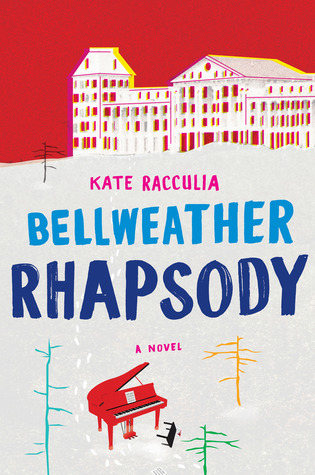Search the Blog
Categories
- Books & Reading
- Broadband Buzz
- Census
- Education & Training
- Friday Reads
- General
- Grants
- Information Resources
- Library Management
- Nebraska Center for the Book
- Nebraska Libraries on the Web
- Nebraska Memories
- Now hiring @ your library
- Preservation
- Pretty Sweet Tech
- Programming
- Public Library Boards of Trustees
- Public Relations
- Talking Book & Braille Service (TBBS)
- Technology
- Uncategorized
- What's Up Doc / Govdocs
- Youth Services
Archives
Subscribe
Tag Archives: Friday Reads
Friday Reads: The All-Girl Filling Station’s Last Reunion by Fannie Flagg
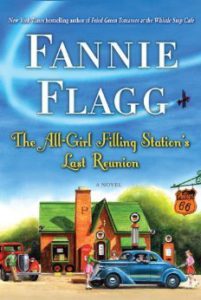 I grew up knowing Fannie Flagg from the ‘70s game show Match Game. Knowing of my love for books and movies, my Southern Uncle took me to visit Juliette, Georgia the actual film location of Fried Green Tomatoes (based on the book of the same name by Fannie Flagg) where a Whistle Stop Café actually exists and operates. I have thought of Fannie as a comedic personality but having read nearly all of her books, she has a knack for balancing humor with poignant story lines and creating very memorable, sometimes outrageous characters and plots.
I grew up knowing Fannie Flagg from the ‘70s game show Match Game. Knowing of my love for books and movies, my Southern Uncle took me to visit Juliette, Georgia the actual film location of Fried Green Tomatoes (based on the book of the same name by Fannie Flagg) where a Whistle Stop Café actually exists and operates. I have thought of Fannie as a comedic personality but having read nearly all of her books, she has a knack for balancing humor with poignant story lines and creating very memorable, sometimes outrageous characters and plots.
Fannie weaves two stories from different families together in this novel. In the first chapter we are introduced to Mrs. Earle Pool Jr., better known to her friends and family as Sookie. Sookie is happily married with four children and a loving husband but unfortunately is burdened with an extraordinarily difficult, high-maintenance mother named Lenore, all living in Alabama in 2005. We are taken back to 1909 Pulaski, Wisconsin and the Jurdabralinsky family. The patriarch, Stanislaw Ludic Jurdabralinsky, emigrated from Poland and he struggles to make a new home for his wife and children by opening a Filling Station that operates with roller skating daughters during WWII. Meanwhile back in 2005, Sookie receives a mysterious registered letter from the Texas Board of Health that puts her identity and her mostly quiet life into a tailspin. The collision of the two stories makes for a delightful read, ending with a twist upon a twist.
The great takeaway of this book for me was learning about the daughters from the Jurdabralinsky family who served in World War II as Women Airforce Service Pilots – WASP for short.
“During the existence of the WASP— 38 women lost their lives while serving their country. Their bodies were sent home in poorly crafted pine boxes. Their burial was at the expense of their families or classmates. In fact, there were no gold stars allowed in their parents’ windows; and because they were not considered military, no American flags were allowed on their coffins. In 1944, General Arnold made a personal request to Congress to militarize the WASP, and it was denied. Then, on December 7, 1944, in a speech to the last graduating class of WASP, General Arnold said, “You and more than 900 of your sisters have shown you can fly wingtip to wingtip with your brothers. I salute you … We of the Army Air Force are proud of you. We will never forget our debt to you.” With victory in WWII almost certain, on December 20, 1944, the WASP were quietly and unceremoniously disbanded. What is amazing is that there were no honors, no benefits, and very few “thank you’s”. In fact, just as they had paid their own way to enter training, they had to pay their own way back home after their honorable service to the military. The WASP military records were immediately sealed, stamped “classified” or “secret”, and filed away in Government archives, unavailable to the historians who wrote the history of WWII or the scholars who compiled the history text books used today, with many of the records not declassified until the 1980s.” taken from: http://www.birdaviationmuseum.com/WASPS.html
This year I read books by Gloria Steinem and Ruth Bader Ginsberg – both advocates for women’s rights; and while Fannie Flagg writes another kind of book, this title fit in nicely and was a great selection for my book club with many things to discuss. If you enjoy audio books, please consider listening to this book as Fannie Flagg is the narrator. I think you’ll enjoy her comic southern accent and stereotypical Wisconsin accent both of which made me laugh many times.
Friday Reads: The Secret History of Wonder Woman
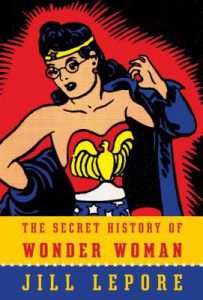 In late October the United Nations celebrated Wonder Woman’s 75th birthday by making her an Honorary Ambassador for the Empowerment of Woman and Girls. You may be wondering how a character, known as much for her “pin-up girl” looks as her crime-fighting skills, achieved such an honor. According to Jill Lepore, author of The Secret History of Wonder Woman (2015), Wonder Woman stands “at the very center of the histories of science, law, and politics.” Lepore argues that the man who conceived of Wonder Woman not only drew from the early-twentieth suffrage and feminist movements, but from his life and “the lives of the women he loved.”
In late October the United Nations celebrated Wonder Woman’s 75th birthday by making her an Honorary Ambassador for the Empowerment of Woman and Girls. You may be wondering how a character, known as much for her “pin-up girl” looks as her crime-fighting skills, achieved such an honor. According to Jill Lepore, author of The Secret History of Wonder Woman (2015), Wonder Woman stands “at the very center of the histories of science, law, and politics.” Lepore argues that the man who conceived of Wonder Woman not only drew from the early-twentieth suffrage and feminist movements, but from his life and “the lives of the women he loved.”
Yep, that’s right. Wonder Woman was created by a man. Not just any man, but William Moulton Marston, the inventor of the lie detector test. Marston was a man of many abilities. In addition to inventing components of the modern polygraph, he also worked as a lawyer, filmmaker and taught psychology prior to becoming a comic book writer. His experiments with lie detection and psychology, in conjunction with a belief in women’s superiority, heavily influenced Wonder Woman’s character. While some of the more suggestive elements later vanished from the strip, Wonder Woman’s feminist message persists.
However, Lepore contends there was more to Marston than met the eye. Unknown except to a few, Marston shared a home with two women: his legal wife and his mistress. Marston married Elizabeth Holloway in 1916. Like Marston, Holloway also held degrees in psychology and the law. Holloway gave birth to two of Marston’s children and worked as an editor and lecturer at American and New York Universities before becoming the assistant to the chief executive at Metropolitan Life Insurance. In the mid-nineteen twenties, Marston became involved with one of his psychology students, Olive Byrne, who also happened to be Margaret Sanger’s niece. Lepore suggests that Holloway allowed Byrne to become Marston’s mistress if Byrne raised Holloway and Marston’s children; permitting Holloway to continue with her career. In time, Marston was the father of Byrne’s two children. The entire family shared a home, with each woman fulfilling her designated role in Marston’s life.
Jill Lepore deftly weaves women’s history through Marston’s biography to create a well-rounded biography of Wonder Woman. A close reading of Wonder Woman comic books reveals many of Marston’s beliefs regarding free love, his complex family life (Wonder Woman’s bracelets are said to honor Byrne who wore a similar pair), patterns of deception and feminist and suffrage themes such as enslavement and bondage. In fact, Lepore argues that “the philosophy of Margaret Sanger’s Woman and the New Race would turn out to be the philosophy of Wonder Woman.” Secret History demonstrates that Wonder Woman is more than skimpy attire and stunning looks, but a pillar of strength and equality – a woman worthy of the title Honorary Ambassador for the Empowerment of Woman and Girls.
Lepore, Jill. The Secret History of Wonder Woman. New York: Vintage Books, 2015.
Friday Reads: Manhood for Amateurs, by Michael Chabon
 Michael Chabon is a Pulitzer Prize-winning novelist. He’s been on my radar for years, but I only recently sought out his work after running across a GQ article he wrote about attending Paris Fashion Week with his 13-year-old son. Because his account of the trip—a bar mitzvah present for his fashion-loving son, Abe—was so loving and insightful, I gravitated immediately to Chabon’s collection of personal essays, Manhood for Amateurs: The Pleasures and Regrets of a Husband, Father and Son, rather than his fiction.
Michael Chabon is a Pulitzer Prize-winning novelist. He’s been on my radar for years, but I only recently sought out his work after running across a GQ article he wrote about attending Paris Fashion Week with his 13-year-old son. Because his account of the trip—a bar mitzvah present for his fashion-loving son, Abe—was so loving and insightful, I gravitated immediately to Chabon’s collection of personal essays, Manhood for Amateurs: The Pleasures and Regrets of a Husband, Father and Son, rather than his fiction.
In Manhood for Amateurs, as the subtitle suggests, Chabon writes about the relationships he’s experienced and the roles he’s played as a boy and a man—son, brother, husband, son-in-law, father. The essays that resonate most with me are those in which he contemplates fatherhood, a role he clearly cherishes. I think I find them so touching because they echo back to me experiences and feelings I’ve had as a parent.
In “William and I” he laments how little it takes to be considered a good father today (still apparently not much more than taking your 20-month-old grocery shopping with you), compared to what it takes to be considered a good mother (“[p]erhaps performing an emergency tracheotomy with a bic pen on her eldest child while simultaneously nursing her infant and buying two weeks’ worth of healthy but appealing break-time snacks for the entire cast of Lion King, Jr.”). He clearly expects more from himself and expresses reverence at the intimacy you develop with your children as a result of the mundane, day-to-day tedium of raising them, especially through “your contact with their bodies, with their shit and piss, sweat and vomit, . . . with their hair against your lips as you kiss the tops of their heads, with the bones of their shoulders and with the horror of their breath in the morning as they pursue the ancient art of forgetting to brush.”
I think what I appreciate most about Chabon’s essays is their honesty, which is both humorous and poignant. In “The Memory Hole,” Chabon begins with an admission that he and his wife regularly throw away a large percentage of the flood of artwork his four children bring home from school. I can’t tell you what a relief it is to hear another parent admit to this. However, what begins as a self-deprecating account of how they try to manage the influx (“We don’t toss all of it. We keep the good stuff—or what strikes us, in the Zen of that instant between scraping out the lunch box and sorting the mail, as good.”), skillfully transitions into a meditation on how quickly childhood passes, how many moments we squander, and how few clear memories we carry forward with us into the future.
In “The Losers’ Club,” the introductory essay in Manhood, Chabon writes about his failed attempt, as a lonely boy in suburban Maryland, to convene a fellowship of likeminded individuals by founding the Columbia Comic Book Club. (No one attends the inaugural meeting, which results in it also being the final meeting.) It feels like a vindication, therefore, when in “The Amateur Family,” one of the last essays in the book, he describes himself as “the geek matrix of four bright geek spawn.” While this essay revolves around the family’s collective love of the Doctor Who television show, what it really celebrates is the fellowship Chabon shares with his children, and that they share with each other: “In the hands, minds, and geekish chatter of my children, I have found again that long-lost, long-desired connection. Each of us stands ready, at any moment, to talk Who, to riff and spin and sketch out new contours for the world we collectively inhabit, creating and endlessly re-creating the fandom that is our family.”
What I love most about “The Amateur Family” is Chabon’s understanding of the innate human drive to connect with others in “a shared universe of enthusiasm”; the fact that he ultimately finds this connection within his own family just makes the account that much more wonderful. Not surprisingly, his respect for and recognition of this impulse also featured prominently in the GQ article on taking his son to Fashion Week—which is what turned me on to this book of essays in the first place. In the GQ article, it’s Chabon’s appreciation of his son’s need to connect with people who share his love of fashion, an interest that Chabon doesn’t share, that I found so moving. He obviously respected his son’s obsession before the trip, or he wouldn’t have taken him on it; but by the end of the trip he gets it—and his son—in a whole new way.
If you like reading meditations on parenthood, I’d definitely recommend this collection of essays. And if you don’t have time to read whole book, at least check out the GQ article!
Chabon, Michael. Manhood for Amateurs: The Pleasures and Regrets of a Husband, Father, and Son. New York: HarperCollins, 2009.
Friday Reads: Books: a Memoir, by Larry McMurtry
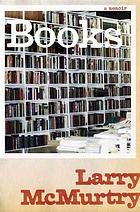 I’ve been a Larry McMurtry fan since reading Lonesome Dove (1986 Pulitzer Prize Winner in Fiction), the only book I recall reading twice. Most likely, I’ll read it again someday. Since then I’ve read many of McMurtry’s books: The Last Picture Show, Comanche Moon, Dead Man’s Walk, Streets of Laredo, and more. Well known as a prolific novelist, McMurtry also has credits as an Academy Award winning screenwriter (Terms of Endearment, Brokeback Mountain and The Last Picture Show to name some), and has added nonfiction writings including Walter Benjamin at the Dairy Queen – a wonderful autobiographical reflection on many things – and particularly those things from his home state Texas.
I’ve been a Larry McMurtry fan since reading Lonesome Dove (1986 Pulitzer Prize Winner in Fiction), the only book I recall reading twice. Most likely, I’ll read it again someday. Since then I’ve read many of McMurtry’s books: The Last Picture Show, Comanche Moon, Dead Man’s Walk, Streets of Laredo, and more. Well known as a prolific novelist, McMurtry also has credits as an Academy Award winning screenwriter (Terms of Endearment, Brokeback Mountain and The Last Picture Show to name some), and has added nonfiction writings including Walter Benjamin at the Dairy Queen – a wonderful autobiographical reflection on many things – and particularly those things from his home state Texas.
McMurtry self describes as a reader, writer, and bookseller. Add teacher, book scout, dealer, business owner to those descriptors. It is his passion for books, book scouting, and book dealing that many might not know of and that is the subject of Books: A Memoir. In Books, McMurtry reflects on his life-long affinity to all things books. The reader will discover that McMurtry knows books, really knows books – all kinds of books.
It’s curious that McMurtry tells of growing up in a house without books and musing that it is perhaps his discovery of books that led to his lifelong passion for them. The absence of books in his home ended when a relative gave him a box of nineteen books, a small batch that the young McMurtry read and re-read many times. When his family moved from their Texas ranch home to Archer City he had opportunities to explore many other books, including those in the local public library.
McMurtry’s book scouting, buying and selling happened in many places, emphasis on many. And those pursuits resulted in acquaintanceships with many book stores and book dealers – a good number colorfully described in Books. I took special notice when he mentions searching, in San Francisco, for a Weldon Kees’ book, and for Wright Morris’s The Home Place.
McMurtry estimates he’s handled over a million books during his lifetime. His own collection, at the time his book was published, numbered nearly 30,000, including a few thousand reference titles.
For over 30 years McMurtry co-owned, with long-time partner Marcia Carter, the legendary Booked Up book store in Georgetown (Washington DC). Booked Up was moved in the mid ‘90s to McMurtry’s Texas hometown in Archer City, eventually growing to several stores housing some 450,000 books (a true book town somewhat on the order of the notable Welsh village of Hay-on-Wye). Sadly, several years ago, McMurtry sold many of the books in these stores – described by McMurtry as “The Last Book Sale.” Fortunately, it wasn’t and he kept Booked Up No. 1, the original store.
For those who love books and fine writing, McMurtry’s Books will be an enjoyable read. And for those who enjoy book stores there is a great adventure ahead in traveling to Archer City, Texas, to visit McMurtry’s remaining store.
McMurtry, Larry. Books: A Memoir. New York: Simon & Schuster, 2008. Print.
Friday Reads: Frankenstein, by Mary Shelley
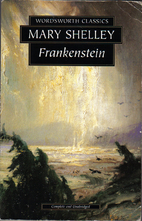
Frankenstein is a remarkably modern book that’s just shy of its bicentennial birthday. Often called the first science fiction novel, it’s a parable for how mastering technology (and the pursuit of knowledge and success that comes along with that) can ruin us if we don’t keep our goals in perspective. Mary Shelley manages to warn us to remember to keep things in balance—without ever coming across as anti-modern or anti-technology. (And she wrote this when she was a teenager—there’s your real Halloween scare.)
Sure, you may have been required to read Frankenstein in high school. You’ll get a lot more out of it when you read it as an adult, trust me. First of all, the structure of the narrative is totally bonkers—it should not work, but it does. I can tell you this without giving away any spoilers: One character is telling his story and another character’s story (and that second character is telling the story of some other characters) and it’s all wrapped up in the narration of yet another character, who is in the middle of writing letters about the whole story he’s hearing—along with his own story. It’s a nesting doll structure that any writer would be wary to imitate. The heavily mediated structure helps illustrate the isolation being experienced by most of the main characters, and at the same time, lends the story an authenticity—a feeling that this may really have happened.
Reading Frankenstein as an adult also allows the reader a lot more insight into what motivates the characters… as well as some skepticism about whether they’re really coming clean with each other. You’ll enjoy giving it a second (or a first) chance.
Frankenstein is available to you in many editions and from many avenues. (Here at the Nebraska Library Commission we even have it as one of our book club kits.) Two common editions are from 1818 and 1831—I’d recommend the 1818 edition myself. Because of the age of the text, it’s available in the public domain, and the Internet Archive has a few editions to choose from. You can also listen to a free audiobook from Librivox here and here, and those are only a couple of the audio versions they have available.
Happy Halloween… and remember, don’t go out there and create your own worst nightmare!
Shelley, Mary W, and Marilyn Butler. Frankenstein, Or, the Modern Prometheus: The 1818 Text. Oxford: Oxford University Press, 2008. Print.
Friday Reads: Altamont
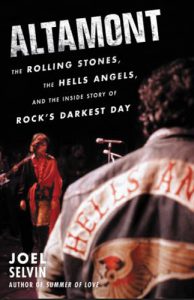 It would be a gross understatement to say that Joel Selvin’s Altamont provides a mere description of the events leading up to and during the Altamont music festival (December 6, 1969). The San Francisco music critic provides much deeper coverage, including the overall music culture at the time, the Woodstock festival, the Rolling Stones, the Grateful Dead, and the lives of musicians and managers that were involved in these and other music events in the late 1960’s. And the other major player at Altamont, the Hells Angels.
It would be a gross understatement to say that Joel Selvin’s Altamont provides a mere description of the events leading up to and during the Altamont music festival (December 6, 1969). The San Francisco music critic provides much deeper coverage, including the overall music culture at the time, the Woodstock festival, the Rolling Stones, the Grateful Dead, and the lives of musicians and managers that were involved in these and other music events in the late 1960’s. And the other major player at Altamont, the Hells Angels.
The organizers of the Altamont festival, which was plugged as “Woodstock West”, unfortunately learned very few of the lessons that came from Woodstock. Altamont was largely a project put together by the Rolling Stones and other assorted handlers that included the Grateful Dead, and was in the end a semi-functional disaster. The Rolling Stones hadn’t toured since 1966, partly due to travel restrictions because of drug charges, and were in a financial crisis so to speak. So in November of 1969 the Stones began touring the U.S., playing large sold-out arenas with ticket prices outside of the norm (and also subsequently skipping from town to town without paying their hotel and travel bills). Altamont was supposed to be the answer to media and fan criticism of the Stones’ high ticket prices, but there were a few other factors at play in their decision to engage in a large scale concert. For one, the Stones weren’t at Woodstock, so there was perhaps an effort for something similar to make their mark (think grand scale). Secondly, the concert, although free to those attending, was always about the money. Perhaps not for a band like the Grateful Dead, but definitely for the Stones. For instance, Selvin describes one of the contributors to the chaos of the event being the multiple changes of venue. At one point, the Sears Point Raceway (now Sonoma Raceway) was selected and theoretically would have been a much better choice for the event than Altamont (after the organizers failed to obtain a permit to hold the event at Golden Gate Park). However, the Sears Point owners requested cash up front and film distribution rights, and the Stones weren’t willing to give that up. In the long run, it would have been well worth it.
In addition to the Stones, the lineup for the Altamont concert included Santana, Jefferson Airplane, The Flying Burrito Brothers, Crosby, Stills, Nash & Young, and the Grateful Dead (although due to increased violence throughout the day of the event, the Dead decided not to play). With the last minute change in venue, one of the problems with the event was the fact that the stage could not be properly erected (and therefore lacked a natural barrier between the musicians and the mixture of LSD, amphetamines, and cheap wine that laced the crowd). The stage stood less than four feet high (compared with 15 feet at Woodstock). Added to the logistical difficulties were huge amount of traffic, inadequate roads, and the lack of other essentials such as food, water, and facilities (yes, those kinds of facilities). Finally (and perhaps most importantly), due to a distrust of the cops, at the suggestion of Jefferson Airplane, the Stones hired no security for the event other than paying the Hells Angels $500 worth of beer (on a truck with ice) in exchange for the Angels agreement to hang out in front and keep the spectators off the stage. And as we all know, the Hells Angels ain’t no cops (especially when they are spending the entire day and night drinking free ice cold beer). The scene at Altamont reeked of trouble from the start, as Selvin offers this depiction of Santana (the first band of the day) beginning to play:
“Santana drummer Michael Shrieve sensed the fog of evil as soon as he settled behind his kit and looked around. The stage felt claustrophobic and the audience packed up against it as tightly as they could. He saw one particularly menacing Hells Angel called Animal, who was wearing a coyote skin as a headdress—the flattened, dried-out head of the long-dead animal hanging grotesquely over his forehead. Something felt wrong from the start. … The Angels waded into the crowd flailing pool cues another half dozen times during the band’s forth-five-minute set, chasing down a hippie photographer who refused to give up his film, smacking around some freaked-out kid trying to escape by climbing onto the stage.”
All said and done, the casualties at Altamont included four deaths, numerous beatings at the hands of the Angels, and general bad vibes. Selvin paints an intriguing and engaging portrait of the events leading up to and during Altamont, as well as the major players. If you have any interest in the historical events of the late 1960’s, the Rolling Stones, or the rock musicians from San Francisco scene during that time, this is an easy and interesting read.
Friday Reads: “Tibetan Peach Pie: A True Account of an Imaginative Life,” by Tom Robbins
In Tibetan Peach Pie: A True Account of an Imaginative Life, Tom Robbins assures us that we are not getting his autobiography or his memoir. What we are getting is a delightful collection of stories, vignettes, memories, and strange—but charming—non-sequiturs from a writer that can just flat-out write. If you grew up in the sixties, you know Tom Robbins from the irreverent, witty, wacky, bestselling novels that he wrote and that readers (me included) devoured the week they were released. With Even Cowgirls Get the Blues, Jitterbug Perfume, Skinny Legs and All, Still Life with Woodpecker (to list a few), Robbins showed a whole generation of counterculture youth the power of words when the writer has the skill to mix sharp wit with dramatic tales.
The stories in Tibetan Peach Pie are presented more or less chronologically, starting from accounts of Robbins’ exploits as a little tyke (nicknamed Tommy Rotten by his mom) in rural Appalachia during the Depression, and moving through a series of careers and numerous marriages that took him on a journey from U.S. Air Force recruit to beatnik, to hippie, to world traveler—all the time observing and writing about his observations. Especially entertaining for me was the section on his stint in Omaha while working for Strategic Air Command and discovering the art scene at the Joselyn Museum and the jazz scene at the Red Lion Inn.
If you read his novels, knowing more about his life at the time the books were written is a bonus. If you’ve not read his novels, just enjoy the ride.
#FridayREADS Tibetan Peach Pie: A True Account of an Imaginative Life by Tom Robbins ( Ecco Reprint Edition, 2015)
Friday Reads: Ghost by Jason Reynolds
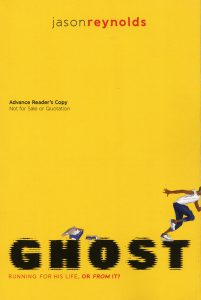 Castle Crenshaw, who tells everyone “call me Ghost,” is in 7th grade. He has been fast ever since he and his mom ran away from his father who was threatening them with a gun. Ghost is often on the edge of trouble, but really doesn’t want any, and doesn’t want to upset his mom. One day he watches a track team practicing, and stands up and races the runner he thinks is too smug. Coach offers him a chance to tryout and be on the team, but he has to keep up his schoolwork and stay out of trouble. He tries, but it is hard for him. Coach knows where Ghost is coming from and has been coaching for years to help kids stay out of trouble.
Castle Crenshaw, who tells everyone “call me Ghost,” is in 7th grade. He has been fast ever since he and his mom ran away from his father who was threatening them with a gun. Ghost is often on the edge of trouble, but really doesn’t want any, and doesn’t want to upset his mom. One day he watches a track team practicing, and stands up and races the runner he thinks is too smug. Coach offers him a chance to tryout and be on the team, but he has to keep up his schoolwork and stay out of trouble. He tries, but it is hard for him. Coach knows where Ghost is coming from and has been coaching for years to help kids stay out of trouble.
Ghost is an appealing character and readers will understand why he gets into trouble and how he sometimes reacts the wrong way. Coach is understanding, but also tough and Ghost knows he is serious about his conditions to stay on the team.
This title is Book 1 in a proposed four book series titled “Track” and I am looking forward to the next book.
Reynolds, Jason. Ghost. New York: Atheneum Books for Young Readers, 2016.
Friday Reads: Bloody Jack, Being an Account of the Curious Adventures of Mary “Jacky” Faber, Ship’s Boy by L.A. Meyer
 I made a new friend this summer. Jacky Faber is many things – fierce pirate, skilled sailor, cunning thief, loyal friend, talented musician, and… a girl. Mary “Jacky” Faber is left on the streets of London in 1797 after an illness takes her parents and sister. After watching too many fellow orphans be done in by the mean streets, she cuts her hair, dresses as a boy, and talks her way into a ship’s boy position on a British naval vessel. For more than 2 years she pulls off her “deception,” despite her maturing body and a blossoming crush on a fellow shipmate, Jaimy. During this time, she earns her nickname “Bloody Jack” after a skirmish with pirates, as well as a promotion to midshipman, before being discovered as female and packed off to a Boston finishing school. Things don’t always go well for Jacky – there are certainly darker elements to her story, as she must avoid lecherous sailors and the hangman’s noose – but she maintains a positive demeanor and always manages to “bob back up.” Readers will gain much in nautical terminology as well as historical facts.
I made a new friend this summer. Jacky Faber is many things – fierce pirate, skilled sailor, cunning thief, loyal friend, talented musician, and… a girl. Mary “Jacky” Faber is left on the streets of London in 1797 after an illness takes her parents and sister. After watching too many fellow orphans be done in by the mean streets, she cuts her hair, dresses as a boy, and talks her way into a ship’s boy position on a British naval vessel. For more than 2 years she pulls off her “deception,” despite her maturing body and a blossoming crush on a fellow shipmate, Jaimy. During this time, she earns her nickname “Bloody Jack” after a skirmish with pirates, as well as a promotion to midshipman, before being discovered as female and packed off to a Boston finishing school. Things don’t always go well for Jacky – there are certainly darker elements to her story, as she must avoid lecherous sailors and the hangman’s noose – but she maintains a positive demeanor and always manages to “bob back up.” Readers will gain much in nautical terminology as well as historical facts.
If you have the option of listening to the audio version, I’d highly recommend that route. Kathryn Kellgren’s treatment of Jacky Faber has often been compared to Jim Dale’s narration of Harry Potter – she really brings the characters to life. Her wonderful voice has led me to have more than a few “driveway moments.”
Bloody Jack is the first of a 12 book young adult historical fiction series which follows Jacky around the globe as she tries to make her way in the world and reunite with her beloved Jaimy. I am currently partway through the tenth book and will sorely miss Jacky when the series ends.
Meyer, L.A. Bloody Jack: being an account of the curious adventures of Mary “Jacky” Faber, ship’s boy. San Diego: Harcourt, 2002.
Friday Reads: Bellweather Rhapsody
Fifteen years after a murder/suicide in room 712, hundreds of talented high school musicians gather for an annual festival at the Bellweather Hotel (which is described as something between the Overlook and the Grand Budapest Hotel).
Twins, Alice and Rabbit, try to imagine life post-high school, a witness to the 1982 tragedy returns to face her fears, the grumpy conductor is missing a few fingers, and the director is disliked by everyone, including the elderly and deeply loyal concierge. Everything goes as well as competitive musical festivals usually go, until a blizzard threatens to trap them inside and Alice’s roommate goes missing. Alice swears it was murder, others believe it’s the ghosts in room 712, or it could all be just a terrible prank.
Friday Reads: The Magicians and Mrs. Quint by Galen Beckett
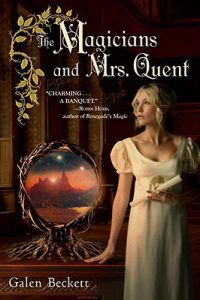
The Magicians and Mrs. Quint
At first all I could see where the parallels with Jane Austen’s Pride & Prejudice, in The Magicians and Mrs Quint, by Galen Beckett, but they fell away. While the era it reverberates with to me is definitely the Regency era in England, the story is at the same time familiar, and strange. When the characters discuss something that in our world would be unusual, in the most normal way one is jarred away from the everyday Regency path. The characters can’t be certain the amount of day or night they will have, except by an almanac. A night may be 30 hours long, and a day less than eight hours of sunlight. And yet this oddity is not ruled by the season or any obvious astronomic explanation.
The story begins with a family just hanging on to gentility, just barely staving off the poorhouse. The father was a magician, until an event working with “magick” cripples his mind. The wife will not have magic spoken of in the house, but the oldest, most sensible sister of three, is fascinated with it, and reads as many books on it as she can in hopes of helping her father. The only thing odd about this is that she’s a woman. Women cannot work magic, of course, or so it is said.
Additionally, two young men who are friends, one attempting to find the financial means to return to College, and the other living a frivolous life, with occasional demands from his father to take on responsibility, go down their paths. While the poor one moves on the edge of conspiracies to make ends meet, the other begins to find magic invading his life.
This is an intriguing book with appealing language and the sparkle of magic. It also has appealing characters, delightful turns of phrase, and plot that never quite moves as you think it will.
Book review of The Magicians & Mrs Quent by Tammy Moore on the SF Site.
Friday Reads: The Celestial Railroad
Like Leonard Nimoy and Thin Lizzy, Nathaniel Hawthorne is somewhat unfairly judged on the basis of his one big hit. I’d wager that lots of you were forced to read The Scarlet Letter at some point in your school days and, like me, did not find it magnificent. Letter is a great book to teach, as it makes literary mechanics very noticeable. But it’s not particularly fun to read, especially when you’re a teen. The prose is dense, words piled high as Hawthorne describes hats and tunics in obsessive detail, and there’s plenty of moralizing. The book’s merits are buried behind the walls of text.
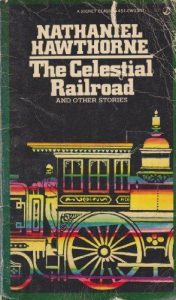 Thankfully, Hawthorne covered a lot of the same themes in his short stories. The excesses that sometimes hampered his novels are excised and what’s left is relatively trim and reader-friendly. There are many echoes of Letter here. Sin and conscience are examined in “Roger Malvin’s Burial”. “The Maypole of Merry Mount” analyzes Puritan society and its distaste for good times. There’s a much better symbol than an A in “The Minister’s Black Veil”. And, though the stories fluctuate in quality, the writing throughout is less laborious than anything in his novels. Hawthorne was a guy writing stories in the 1800s and the stories were mostly about the 1600s and 1700s, so it’s unfair to expect him to read like Janet Evanovich. But the prose here has some life and sometimes he even dips into very black humor:
Thankfully, Hawthorne covered a lot of the same themes in his short stories. The excesses that sometimes hampered his novels are excised and what’s left is relatively trim and reader-friendly. There are many echoes of Letter here. Sin and conscience are examined in “Roger Malvin’s Burial”. “The Maypole of Merry Mount” analyzes Puritan society and its distaste for good times. There’s a much better symbol than an A in “The Minister’s Black Veil”. And, though the stories fluctuate in quality, the writing throughout is less laborious than anything in his novels. Hawthorne was a guy writing stories in the 1800s and the stories were mostly about the 1600s and 1700s, so it’s unfair to expect him to read like Janet Evanovich. But the prose here has some life and sometimes he even dips into very black humor:
“[T]here sat the light-heeled reprobate in the stocks; or if he danced, it was round the whipping post, which might be termed the Puritan Maypole.”
Yikes! My favorite aspect of these stories is the treatment of the Puritans. Hawthorne was viewing America’s past from the rapidly-changing nineteenth century. Transcendentalists like Emerson and Thoreau were popularizing sensitive, romantic spirituality—pretty much the polar opposite of hard, cold Puritanism. And yet Hawthorne never really depicts Puritans as simply primitives or America’s embarrassing, witch-hating grandparents. He portrays the past in an even-handed way, not as a bunch of villains and their victims: the “immitigable zealots” of “Merry Mount” are also the anti-despots of “The Gray Champion”. Both good and bad get their time in the spotlight. Scarlet Letter and House of Seven Gables covered much of the same ground, but it’s conveyed more effectively in these short stories.
If you have sad memories of Hawthorne, I’d recommend giving a collection like this a try. It sometimes pays to give the classics a second look.
Hawthorne, N. (2006). The celestial railroad, and other stories. New York: Signet Classics.
Friday Reads: Midnight in the Garden of Good and Evil
What do the following have in common?
- An outrageous, irrepressible drag queenA piano-playing attorney who stays one step ahead of creditors by serially squatting in local mansions
- An antiques dealer tried for one murder four times over nine years who enlists the help of a local voodoo priestess in his defense
- The gravesites of song writer Johnny Mercer and poet Conrad Aiken
- A college bulldog mascot dressed for game day in suit and tie
- A local debutante whose mother hires Peter Duchin and his orchestra for her party
- A failed inventor who reportedly possesses a poison powerful enough to spike the water supply and kill everyone in town
- A pianist/singer who knows 6,000 songs by heart and recognizes no speed limit when driving from gig to gig
All of these characters and situations – and more – appear in the novelized, non-fiction book Midnight in the Garden of Good and Evil by John Berendt. The author, a magazine writer in New York City for decades, discovered the magic of airline supersaver fares in the early 1980s which offered travel to U.S. cities for less than the nouvelle cuisine restaurant meals he critiqued. Through cheap travel to a sampling of continental U.S. cities, the author finds himself drawn more and more to Savannah, Georgia with its charms and eccentricities, so much so that he finally ends up living more of the year there than in NYC.
This title happens to be the one our Nebraska Library Commission book club will be discussing at its August session (and we have a book club kit in case your local group would like to read it). From shocking, to laugh-out-loud funny, the book manages to draw in the reader into the lives of the characters. Ultimately, Savannah itself becomes a character. Its history is fascinating. One example is that fact that, through southern charm and good manners, the then-mayor managed to talk the union general Sherman out of burning the city to ground in his march across the south.
The city itself, however, is not all charm and hospitality, with its beautiful squares that form the basis of the “old” Savannah. The city has traditionally stiff-armed any attempts to bring in local economic development and any chain stores. Such entities moved on up or down the road to Augusta or Atlanta. But the lack of economic opportunity, the still-present stratification of society along black and white lines certainly contributed to Savannah being named “Murder Capital of the U.S.” at one point.
Give it a try. I think you will be charmed, shocked and tickled with Mr. Berendt’s loving yet dispassionate treatment of Savannah. It certainly has led me to put the city on my list of must-see places sometime in my life.
Friday Reads : The Little Paris Bookshop
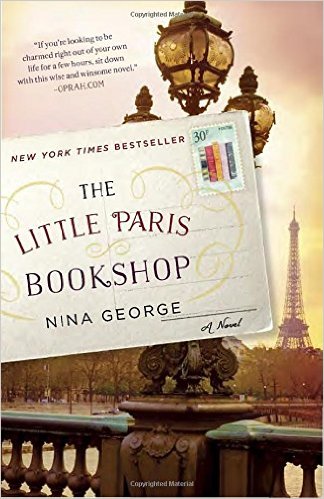 “Monsieur Perdu calls himself a literary apothecary. From his floating bookstore in a barge on the Seine, he prescribes novels for the hardships of life. Using his intuitive feel for the exact book a reader needs, Perdu mends broken hearts and souls. The only person he can’t seem to heal through literature is himself; he’s still haunted by heartbreak after his great love disappeared. She left him with only a letter, which he has never opened.
“Monsieur Perdu calls himself a literary apothecary. From his floating bookstore in a barge on the Seine, he prescribes novels for the hardships of life. Using his intuitive feel for the exact book a reader needs, Perdu mends broken hearts and souls. The only person he can’t seem to heal through literature is himself; he’s still haunted by heartbreak after his great love disappeared. She left him with only a letter, which he has never opened.
After Perdu is finally tempted to read the letter, he hauls anchor and departs on a mission to the south of France, hoping to make peace with his loss and discover the end of the story. Joined by a bestselling but blocked author and a lovelorn Italian chef, Perdu travels along the country’s rivers, dispensing his wisdom and his books, showing that the literary world can take the human soul on a journey to heal itself.
Internationally bestselling and filled with warmth and adventure, The Little Paris Bookshop by Nina George is a love letter to books,” a masterpiece of character description, and “meant for anyone who believes in the power of stories to shape people’s lives.”
Reprinted from Amazon.
Posted in Books & Reading, General, Information Resources, Library Management, Programming, Uncategorized
Tagged Friday Reads
Leave a comment
Friday Reads: My Kitchen Year: 136 Recipes That Saved My Life by Ruth Reichl
 I first read Ruth Reichl (pronounced RYE-shil) when I selected the book Tender at the Bone: Growing Up at the Table for my book group several years ago. I knew Reichl had been a food critic, but wasn’t aware of her connection to Gourmet magazine until I heard of its demise in 2009. Reichl was the editor of Gourmet when it came to the tragic end of its 69 year run. This book recounts her grief in the aftermath, during the days and months as she moved beyond job loss.
I first read Ruth Reichl (pronounced RYE-shil) when I selected the book Tender at the Bone: Growing Up at the Table for my book group several years ago. I knew Reichl had been a food critic, but wasn’t aware of her connection to Gourmet magazine until I heard of its demise in 2009. Reichl was the editor of Gourmet when it came to the tragic end of its 69 year run. This book recounts her grief in the aftermath, during the days and months as she moved beyond job loss.
Some of us turn to food for emotional reasons and Ruth returned to her kitchen as her way of healing, pairing food with personal events, and an honest and very personal dialog of working through change. I agree with a statement in her introduction: “…recipes are conversations, not lectures.” It registered with me because I’ve usually considered recipes more like guidelines as I negotiate the ingredients and their amounts.
For those who love cookbooks, photos are an absolute must. In this book, the pictures are informal and homey, supporting the intimacy of her diary format. She begins each daily entry with a tweet to her very active twitter followers who also serve as part of her support. If you prefer the audio edition, Ruth narrates and she is an author who is genuinely meant to read her own material. You might think that listening to someone read 136 recipes would be a bit banal but Ruth is a genuine story teller and her throaty alto voice is as much of a comfort as the recipes she prepares. As Ruth says: “…I finally understand why cooking means so much to me. In a world filled with no, it is my yes.”
Not your ordinary cookbook – it’s like spending time with someone who likes food just as much as you – at the market, in the kitchen or at the table. Ruth chronicles four seasons of food and recovery in the kitchen, transforming from broken to hopeful. I’ve read other books of hers, but this one particularly stands out for me. It also makes a terrific gift for the food lover in your life.
Friday Reads: The Passage Trilogy by Justin Cronin
In 2010 Justin Cronin published The Passage, the first book in The Passage Trilogy. Set roughly 100 years after the accidental release of thirteen vampire-like test subjects (virals), The Passage focuses on one of the few remaining human settlements. After their release from a government facility, the virals killed or infected the majority of Americans, leaving few behind. With their food supply and power resources dwindling, a small band sets out in search of other survivors. They also seek the story of a mysterious young girl, Amy, who is not what she seems. Led by a young man named Peter, they find some answers.
The subsequent novels, The Twelve (2012) and The City of Mirrors (2016), follow Peter’s three decade journey to defeat the virals, as well as discover the truth about Amy. During this period, it appears as though the virals have been destroyed. Their disappearance results in the population spreading beyond their walled settlements. However, not all is as it seems. Unbeknownst to Peter and his allies, the virals are massing for a series of attacks. The City of Mirrors focuses on these battles, as well as a herculean attempt to save the remaining survivors.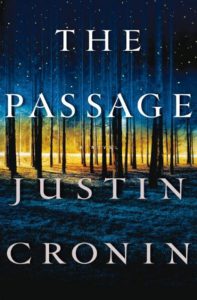
While The Passage Trilogy serves as a classic example of post-apocalyptic fiction, Cronin draws from works such as the Bible and Bram Stoker’s Dracula to create a nuanced and multi-layered story. His characters are more than words on a page, but living, breathing human beings. It would have been easy for Cronin to rely on stereotypes such as the damsel in distress, the classic loner or the all-conquering hero. These are not perfect people, but deeply flawed and damaged individuals, who, for whatever reason, refuse to give up hope. Rather, Cronin explores their faults – how these weaknesses enable them to survive and even grow. Despite their faults, or perhaps because of them, characters such as Peter are likeable. Ultimately, this story centers on relationships and what ties us together as a society, as a race.
Cronin is an excellent writer, with a fluid and relatable style of writing. Unlike similar trilogies, the story does not get bogged down in the details. Additionally, there are no slow parts, where the story stops moving. Even when there is little action, Cronin continues to move the story forward. Each time I read his books, I feel like I am reading them for the first time. Often, they give me the chills and I have to stop reading. If you are a fan of vampires and post-apocalyptic fiction, then I highly recommend this series.
Cronin, Justin. The Passage. New York: Ballantine Books, 2010. Print.
Cronin, Justin. The Twelve. New York: Ballantine Books, 2012. Print.
Cronin, Justin. The City of Mirrors. New York: Ballantine Books, 2016. Print.
Friday Reads: “Runaway” by Alice Munro (Vintage, 2005)
 This stunning collection of short stories illuminates the human condition—warts and all! “Runaway,” the title story, is such a carefully crafted examination of three flawed humans that when I reached the end I sucked in my breath, put the book down, and debated whether to pick it back up again to read the next story. Eventually I did and I’m so glad I did, but I did need a little time to catch my breath.
This stunning collection of short stories illuminates the human condition—warts and all! “Runaway,” the title story, is such a carefully crafted examination of three flawed humans that when I reached the end I sucked in my breath, put the book down, and debated whether to pick it back up again to read the next story. Eventually I did and I’m so glad I did, but I did need a little time to catch my breath.
“Powers,” divided into five sections, uses diary entries and letters to tell the story in the real, genuine voices of the characters. We meet these characters over a period of time and the interplay between them really shows the depths of their personalities and their true natures. The story shows a lifelong journey toward self-awareness, but do they make it to the destination?
One set of stories— “Chance,” “Soon” and “Silence,” —allows us to peek in on the protagonist’s life at various stages. Together these three stories give such a complete detailed picture of her that readers feel like we know her very well, even though we’ve only seen her through three short vignettes. As with all these stories, we may get to know ourselves a little better as we reflect on her feelings and reactions to key incidents in her life.
Munro’s skill as a writer is so evident in all of these stories. She is never manipulative, always presenting straight-forward and minimalist prose. And did I mention stunning? In 2013, she won the Nobel Prize in Literature for “Dear Life: Stories” (Vintage, 2012), another book that demonstrates why she is considered by many to be the “best short-story writer in English today.”
Spoiler Alert (especially for my Bookclub): If you are into happy endings, they are not to be found in this book. But even though the stories are dark, the prose is so light that they are not depressing—just sad. But I promise you’ll be thinking about these characters and their stories long after you finish the book.
Friday Reads: Grasshopper Jungle, by Andrew Smith
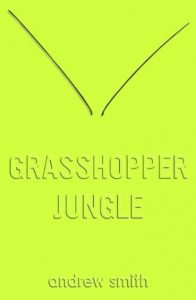 I first listened to Andrew Smith’s Grasshopper Jungle in fall 2015, and it instantly became my new favorite book! Since then I’ve read other Smith books (Winger, Stand-Off, 100 Sideways Miles, The Marbury Lens), and while I liked them all I’d have to say that Grasshopper Jungle stands out as something completely unique. As a piece of writing, it is distinctive – not just from Smith’s other books but from most other books I’ve read!
I first listened to Andrew Smith’s Grasshopper Jungle in fall 2015, and it instantly became my new favorite book! Since then I’ve read other Smith books (Winger, Stand-Off, 100 Sideways Miles, The Marbury Lens), and while I liked them all I’d have to say that Grasshopper Jungle stands out as something completely unique. As a piece of writing, it is distinctive – not just from Smith’s other books but from most other books I’ve read!
In part, this might be because Smith wrote it at a point in time when he had decided to get out of the business of writing for publication. “I never felt so free as when I wrote things that I believed nobody would ever see. Grasshopper Jungle was one of those things,” he confesses in the acknowledgements section of the book, which someone else evidently did read since they convinced him to publish it. (Publication was obviously a good idea: Grasshopper Jungle was a 2015 Michael L. Printz Honor Book.)
What the book is ostensibly about, versus what I love about it, are two different things. On the surface, this book is about an apocalyptic plague of six-foot-tall, man-eating praying mantises, accidentally unleashed in the fictional, economically-depressed town of Ealing, Iowa. What I love most are the main characters, sixteen-year-old Austin Szerba, who narrates, and his best friend, Robby Brees. They are, among other things, smart, sincere, loyal, witty, matter-of-fact, unflinching, hilarious, and respectfully profane.
One thing I particularly love about Austin is his obsession with history and truth, which are recurring themes throughout the book. Austin begins his narration with the following rumination on history:
I read somewhere that human beings are genetically predisposed to record history.
We believe it will prevent us from doing stupid things in the future.
But even though we dutifully archived elaborate records of everything we’ve ever done, we also manage to keep on doing dumber and dumber shit.
This is my history.
Austin has been recording his own history for years, as evidenced by the thigh-high stack of journals in his closet; and his book narration is a continuation of this process. Included in Austin’s stream-of-consciousness recitations are his thoughts on the nature of history, the act of recording it, and the impossibility of getting it all down. These thoughts, at least in my opinion, inform, and are reinforced by, the stylistic quirks that permeate Smith’s writing in this particular book.
These quirks include repetition of words and phrases to the point where they become epigrammatic refrains; use of an almost clinical, detached language to describe horrifying and distressing events; and Austin’s practice of reporting not just the main event, but also a multitude of other events that are occurring simultaneously, to other people, in other parts of the world. While this last quirk would be considered digression in another book, in Grasshopper Jungle it is a manifestation of Austin’s beliefs about how to report history in order to approach the truth. Austin’s girlfriend Shann describes his process thusly: “I love how you tell stories. I love how, whenever you tell me a story, you go backwards and forwards and tell me everything else that could possibly be happening in every direction . . . .”
Elsewhere, addressing the futility of this endeavor, Austin states: “You could never get everything in a book. Good books are about everything;” and “Even when I tried to tell everything that happened, I knew my accounts were ultimately nothing more than an abbreviation.”
Austin is as devoted to telling the truth as he is to accurately recording history. To others, he never lies, especially if asked a direct question. The most he sometimes does is not volunteer the whole truth. (About a partial truth he told his parents, he says: “It wasn’t a lie; it was an abbreviation.”) From himself, he hides nothing, even if the truth is embarrassing or confusing. It’s why he doesn’t shy away from the realization that he is in love with, and sexually attracted to, both his best friend Robby, who is gay, and his girlfriend, Shann. He might not know what to do about these feelings, he might not know what they mean, but he never tries to lie to himself about them.
I also love the fact that Austin and Robby have favorite poems, which they recite out loud to each other. According to Austin:
Robby’s favorite poem is Dulce Et Decorum Est by Wilfred Owen. It is a poem about war and lies, youth and thievery. . . .
My favorite poem is The Emperor of Ice-Cream by Wallace Stevens. It is a poem about everything else: sex, lust, pleasure, loneliness, and death. . . .
Because favorite poems often reveal something about character, and because I suspected they might reinforce the underlying themes of the book, I sought them out to read in their entirety. Although very different on the surface, both call on readers to reject artifice and sentimentality in favor of seeing things exactly as they are – at least to the extent humanly possible. In “Dulce Et Decorum Est” a gruesome description of a World War I soldier choking to death on poisonous gas is presented in stark contrast to the slogan (“That old Lie”) used to encourage young men to enlist at the start of the war: “Dulce et decorum est / Pro patria mori.” (The Latin phrase, borrowed from Horace, can be translated as “it is sweet and right to die for your country.”) And in “The Emperor of Ice-Cream” we are told to “Let be be finale of seem.” This philosophy definitely informs Austin’s approach to recording history, as evidenced by the matter-of-fact tone and blunt language he favors in his narration, along with his commitment to objectivity: “I do not know why, but that is not my job. My job is saying what.”
If you like quirky, irreverent books with absurd plots, which also have depths you can plumb, Grasshopper Jungle might be for you. As Andrew Smith said in a February 18, 2014 interview with Walter Heymann, “. . . Grasshopper Jungle is very realistic, but at the same time, it’s absolutely ridiculous. It’s the same way our world is.”
Smith, Andrew. Grasshopper Jungle. New York: Dutton, 2014.
Friday Reads: M Train
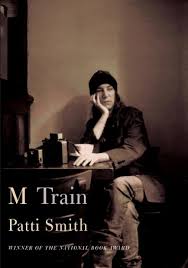 My awareness of Patti Smith was that of a rock musician, and more specifically one influential in the punk rock genre. There wasn’t all that much awareness and not much interest. Then I heard her interviewed on National Public Radio’s Fresh Air. I learned that Smith is not only a singer-songwriter musician, she is an accomplished poet, writer and artist. That interview was from several years ago when she wrote Just Kids, the 2010 National Book Award winner for nonfiction. Just Kids is the story of Smith’s younger years (1960s and ‘70s) as a developing artist and her friendship with photographer Robert Mapplethorpe.
My awareness of Patti Smith was that of a rock musician, and more specifically one influential in the punk rock genre. There wasn’t all that much awareness and not much interest. Then I heard her interviewed on National Public Radio’s Fresh Air. I learned that Smith is not only a singer-songwriter musician, she is an accomplished poet, writer and artist. That interview was from several years ago when she wrote Just Kids, the 2010 National Book Award winner for nonfiction. Just Kids is the story of Smith’s younger years (1960s and ‘70s) as a developing artist and her friendship with photographer Robert Mapplethorpe.
More recently I heard Smith interviewed on another Fresh Air program following publication of her most recent book, M Train. Smith is quoted as describing M Train as “a roadmap to my life.” The book is a memoir with mixed reflections about many things including her marriage to Fred “Sonic” Smith, family life, wanderings, music, and relationships. Notable to me was her favored writing locale – a Greenwich Village café – and her passion for TV cop shows. There are commentaries about her travels, New York City life, and her fondness for hot black coffee. There is also the curiosity of her purchase of a run-down seaside bungalow timed, unfortunately, just prior to Hurricane Sandy’s arrival.
Patti Smith came across to me as an extraordinarily gifted yet down to earth person. Seeing her writing in her notebook at a corner table in her favorite café wouldn’t be all that memorable. But her reflections are memorable and M Train is a remarkable book.
Smith, Patti. M Train. (New York: Alfred A. Knopf). 2015.
Friday Reads: Brain on Fire, by Susannah Cahalan
 Brain on Fire: My Month of Madness is a medical memoir that may have caught your eye on library shelves—an attractive young woman on the cover, an author’s name spelled in a way that patrons (and maybe even staff) would search for incorrectly—it’s Susannah Cahalan, not Callahan. You’ll see buzz about it again soon, because a movie based on the book is in post-production—starring Chloe Grace Moretz.
Brain on Fire: My Month of Madness is a medical memoir that may have caught your eye on library shelves—an attractive young woman on the cover, an author’s name spelled in a way that patrons (and maybe even staff) would search for incorrectly—it’s Susannah Cahalan, not Callahan. You’ll see buzz about it again soon, because a movie based on the book is in post-production—starring Chloe Grace Moretz.
Brain on Fire is the compelling tale of a young professional who exhibits disturbing behavioral symptoms, which are easily misdiagnosed by medical professionals looking for horses instead of zebras. Their incorrect diagnoses lead to treatments that do more harm than good. Cahalan’s symptoms seem to suggest mental illness, which doctors are eager to label her with since she’s a young woman in a stressful profession. One doctor is sure she’s “partying too much.” But the truth is more complicated, because her brain and body are in battle with each other. She has a rare autoimmune disease, only recently discovered. It’s only because of Cahalan’s tenacity that she keeps searching for better treatment—and she knows that’s she’s lucky to have the skills to advocate for herself, and to be able to find a doctor current enough on research to be able to see the real problem. Not every person with the illness would be so fortunate. (This is where the reader gets scared, if they aren’t already frightened by the author’s symptoms which are reminiscent of Friedkin’s Exorcist.) Her family is a big part of her confidence, and her recovery, and she writes about them with compassion and honesty. Getting to the correct diagnosis is the first half of the journey—then the treatment and recovery are dramatic as well, and will keep you turning the pages.
Brain on Fire is different from other examples of the popular genre of medical memoir because it’s not written by a medical professional (where, suddenly, their field is humanized for them) or by a complete layperson (where the author is at first lost in jargon but comes to an understanding about their disease). Our author, Susannah Cahalan, is an up-and-coming investigative reporter at the New York Post at the beginning of the book, and she uses her journalistic skills both to research her illness and to describe her journey through her illness. Her disease takes away her ability to work, and her career is very important to her. This book is her way of showing her chops in her field—she wants to prove she’s ready to get back in the game of newspaper work. Writing the book is an act of redemption for Cahalan—a way to illustrate that she has her identity and ability back. Cahalan also co-wrote the movie screenplay with director Gerard Barrett (who’s helmed gritty Irish dramas Pilgrim Hill and Glassland). The author’s perspective on her illness and her life make this medical memoir cross over into a coming-of-age story—a young woman fighting to establish her place in the world, and in her own life, and even in her own body and mind.
I’d recommend Brain on Fire to medical memoir fans, and the New Adult/Mature YA reader. It is a surprisingly quick and attention-grabbing read for a heavy topic, so it’s a good plane read as well. You might think that since Cahalan was a reporter for the New York Post that the book would have a “Man Bites Dog” tone to the narrative—I was hesitant about the book for that reason at first, but I was pleasantly surprised by her enjoyable style. The tone is approachable and authentic, like an especially engrossing magazine article; but it’s still written with the authority of a piece that’s been thoroughly fact-checked. No one’s going to come back and tell you it was boring.
Cahalan, Susannah. Brain on Fire: My Month of Madness. New York: Free Press, 2012. Print.
